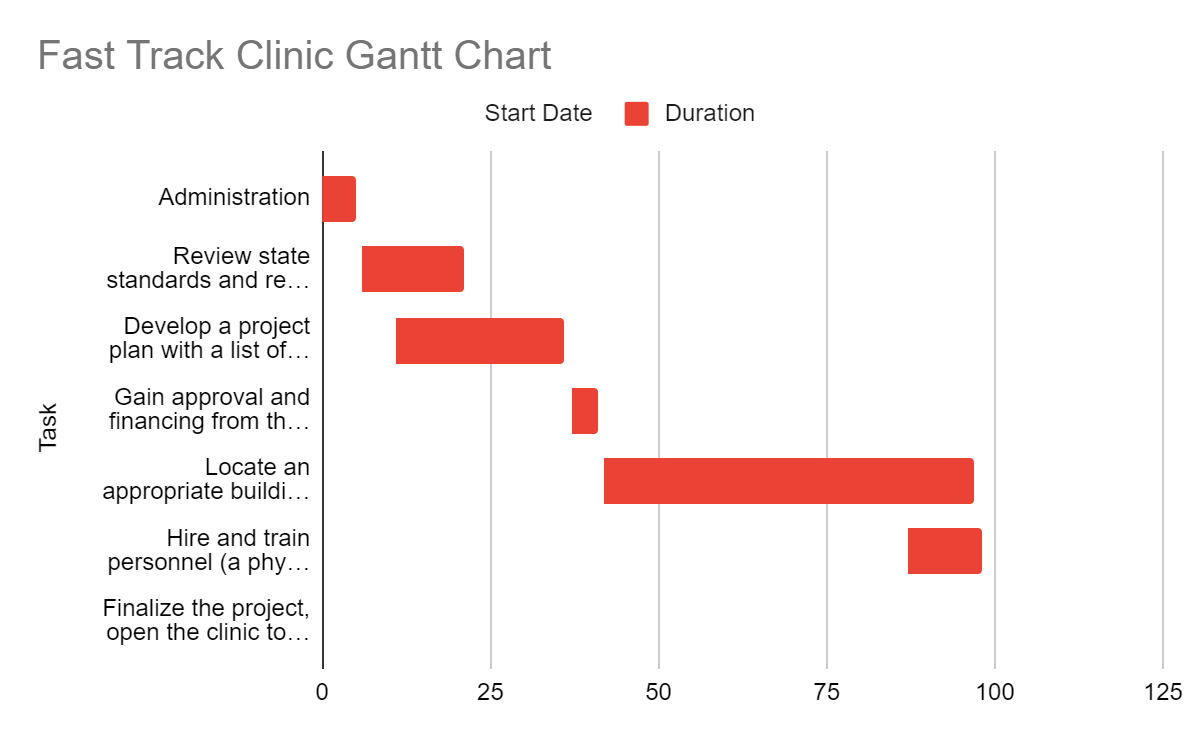Introduction
Project Mission Statement
To create a fast track clinic where non-urgent patients can be treated to reduce the number of patients in the Emergency Department (ED), improve quality of care and satisfaction rates.
Project Objectives
The objectives of the project are as follows:
- Establish a fast-track clinic for the hospital’s patients.
- Reduce the number of patients, who are admitted to the ED.
- Refer all patients who do not require urgent care to the fast track clinic.
- Reduce waiting times for patients, both in the ED and the Fast Track Clinic.
- Improve patient’s lengths of stay from admission to discharge.
- Reduce the number of hospitalizations by providing urgent care to patients in the ED.
- Create additional bed availability for the clinic and ED.
- Provide care to all patients in compliance with the Emergency Medical Treatment and Active Labor Act (EMTALA).
- Increase the number of available hospital beds in the facility.
Work Breakdown Structure
Project Schedule
Gantt Chart
The Gantt chart presented as Chart 1 illustrates the duration of each task, outlined in the previous section. The majority of tasks in this project do not overlap, except for the review of standards and regulations for Fast Track Clinics and the development of the project construction plan and hiring a physician assistant and a nurse practitioner, which should happen while the clinic’s building is being renovated.

Resource Utilization
Funding Source
Knowing how to fund a project is one of the essentials that a project manager should determine, otherwise, they will be unable to complete other stages outlined in the project plan (“Project funding requirements,” n.d.). The construction of this clinic and the first quarter of its operations will cost this hospital approximately $308,357.25, including capital expenses, construction, new equipment, and yearly salaries for the personnel. Considering the hospital’s net revenue of $75,779 in Year 1, it will be impossible to fund the fast track clinic from the hospital’s own resources.
In general, there are two other options for obtaining the funds necessary to construct the fast track clinic — donations and loans. Donations, as a source of funding, are a high-risk strategy. A loan, however, can be a more valid approach in this case. Firstly, the hospital’s ED is already overwhelmed by the number of individuals admitted to the ED, and the quality of care is becoming worse due to prolonged waiting time and extensive duration of hospitalizations. Since one can assume that the number of Levels I visits during this year is 252, all of which can be addressed by the Fast Track Clinic. Moreover, some Level II and III cases can also be referred to this clinic upon triaging. Hence, the additional revenue that the clinic will have in year one is estimated at $43,848 based on the calculations of revenue and expenses for Level I cases. This means that the clinic is a promising project in terms of profits, and a loan can be used to account for the initial investment.
Project Budget
The table below presents all of the anticipated expenses for this project, including fixed costs such as equipment, construction, and marketing and reoccurring payments, such as salaries. The project’s revenue was calculated using the data and projections for the number of Levels I cases that the ED had in 2017 and was expected to have in the future. Hence, the previous year, the ED’s department had revenue of $167,611 from Level I cases, however, the number of these cases is expected to grow this year from 49 in 2015 to 252 in the following year. Hence, this budget considers the hospital’s previous revenue and additional cases, which should result in a revenue of $219,000 for the first year.
For the purpose of this project, it is assumed that the majority of the Level II and Level III cases can be referred to this clinic after triaging, meaning that the clinic will receive an additional $689,340 in revenue from these cases. However, it is expected that these cases will grow by 11% this year, resulting in the clinic receiving an additional $75,827. As a result, the total revenue anticipated from opening a Fast Track Clinic is $984,167 in the first year. Additionally, the expected yearly expenses are $912,144. Based on the general hospital costs for five years of operations, it can be assumed that most expenses will remain unchanged, apart from the salaries and benefits of the physicians and nurses within the next five years.
Assumptions and Risk Analysis
Assumptions of the Project
- Patients will use the services of the Fast Track Clinic and will be receptive to its services.
- The number of patients with Levels I, II, and III cases admitted to the Fast Track clinic will be the same or bigger than the number of these cases in the ED from previous years.
- Physicians and the other personnel will participate in establishing the workflow of the clinic.
- The hospital can allocate space for the construction of the Fast-Track Clinic.
Risk Analysis and Mitigation
References
Applying for grants to support rural health projects. (n.d.). Web.
Project funding requirements. (n.d.). Web.
American Association of Nurse Practitionnairs. (2018). How to: Market your practice. Web.